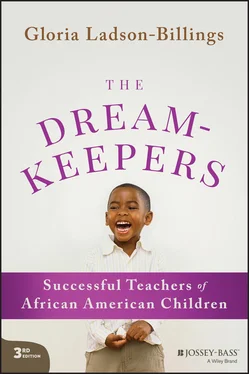Historically, African Americans have wrestled with the problems of a quality education and integrated schooling. For some, a quality education does not necessarily mean attending schools with whites. As far back as the post–Civil War era there were African American champions of separate schools. At the constitutional convention of North Carolina, one African American delegate said: “I do not believe that it is good for our children to eat and drink daily the sentiment that they are naturally inferior to the whites … . I shall always do all that I can to have colored teachers for colored schools. This will necessitate separate schools as a matter of course, wherever possible, not by written law, but by mutual consent and the law of interest.” 14
However, not all African Americans believe that separate schools are the answer. In her study, Irvine found that many African Americans believe that resources and quality follow the white students. 15 When they look at the physical facilities and the instructional materials and other resources of middle-class white schools and compare them with inner-city schools, African American parents cannot help but surmise that where white children are there is educational excellence. Irvine found that middle-income African American parents who voluntarily sent their children to suburban white schools for purposes of desegregation routinely commented that these schools were of higher quality because they had more computers. Similarly, W.E.B. Du Bois initially felt that separate African American schools had little to offer: “The well-equipped Jim Crow school is a rare exception. For the most part, such schools have been run on wretchedly inadequate resources, taught by ignorant teachers; housed in huts and dumps; and given just as little attention and supervision as the authorities dared give them.” 16
But after witnessing the persistent mistreatment of African American students in desegregated Northern schools, Du Bois turned his efforts toward making the separate African American schools quality schools that offered equal education, not integrated education.
Certainly at the college level Fleming has demonstrated that African American students attending historically black colleges and universities (HBUCs) have significantly higher graduation rates than those attending predominately white institutions. 17 Further, the graduates' ability to function successfully both in the workplace and at predominately white graduate and professional schools is not compromised by their having attended African American undergraduate schools.
Indeed, some argue that school integration has come at considerable cost to African American students. Researchers investigating the performance of African American students in desegregated schools indicate that they fare no better than those attending segregated schools. 18 Lomotey and Staley suggest that school desegregation plans are deemed successful when white parents are satisfied, despite low academic performance and high suspension and dropout rates for African Americans. 19 The figures for African American males, in particular, are quite disturbing because of their overrepresentation in the suspension and dropout rates.
This assessment—that success of desegregation is determined by the white community's level of satisfaction—is consistent with a fictionalized account (based on actual reports of school desegregation) in law professor Derrick Bell's And We Are Not Saved: The Elusive Quest for Racial Justice . 20 In his discussion of the impact of school desegregation laws, Bell argues that the real beneficiaries of school desegregation are the schools, the white communities, and the white students. Desegregation often brings big dollars to a school district, which go toward instituting new programs, creating new jobs, providing transportation, and supporting staff development. Each of these means more personnel and better salaries. When white students are bused to African American schools, “desegregation money” is used to transform them into “magnet” schools—schools that attract students from throughout the district because they offer exemplary programs in mathematics, science, technology, the performing arts, and so on. Unfortunately, these magnet schools sometimes operate under a two-tiered system, virtually resegregating students within the so-called desegregated schools. Thus the white students who come to the schools benefit from the special program while the African American students remain in the low-level classes.
Lomotey and Staley report additional perks in the form of free extracurricular programs—such as after-school care, pre-school programs, and camping or skiing trips—to entice white students to attend these schools in African American and other nonwhite communities. These extras are open to all students, but the nature of these special enticements often makes them of less interest or importance for African American students. For example, few low-income African American students have the resources or the equipment to enjoy camping or skiing.
McPartland 21 concluded that only when individual classrooms are desegregated is there an improvement in the achievement levels of African American students. This suggests that the classroom itself, where students come face to face with others who are different from themselves, is the place for real integration. When they are in the same classroom, all students can take advantage of the benefits and instructional expertise that may have been reserved previously for “upper-track” (that is, white middle-class) students.
Separate Schools or Special Schooling?
As a member of the baby boom generation, I went to urban schools that were bursting at the seams; every classroom had at least thirty students. Further, almost all of the children and most of the teachers were black. But the important thing was that the teachers were not strangers in the community. We students knew them and they knew us. We saw them at church, in the beauty parlor, in the grocery store. One of the sixth-grade teachers had served in the Army with my father. Most importantly, the teachers knew our families and had a sense of their dreams and aspirations for us .
Let us suppose that the legal, moral, and ethical concerns about special separate schools could either be suspended or reconciled with the American ideal of equality. Let us further suppose that every major urban center with a large number of African American students would set about developing separate schools for these children. One fundamental question would remain. Who would teach the children?
The uproar over separate schools has masked the debate about the quality and qualifications of the teachers who teach African American students. There is very little reliable literature on preparing teachers for diversity. 22 And almost nothing exists on teacher preparation specifically for African American students. 23
Although the 1960s produced a large body of literature on teaching the “disadvantaged” 24 and the 1970s produced a body of literature about “effective schools,” 25 none of it was aimed specifically at preparing teachers to meet the needs of African American students. Even today some of the more popular educational innovations, such as cooperative learning and whole-language approaches to literacy, were developed and refined to improve achievement among “disadvantaged” students. Unfortunately, the relationship of these practices to African American learners is rarely made clear.
Elizabeth Cohen, a Stanford University sociologist, is one of the pioneers in the research of cooperative or small-group learning. Although her work in designing such classroom structures has received critical acclaim throughout the educational community, its link to her early work in facilitating school desegregation in Northern California is rarely acknowledged. 26
Читать дальше












